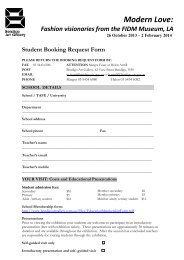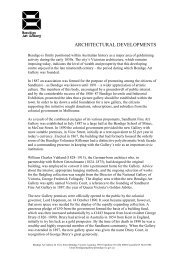Collection Management Manual Handling - Bendigo Art Gallery
Collection Management Manual Handling - Bendigo Art Gallery
Collection Management Manual Handling - Bendigo Art Gallery
Create successful ePaper yourself
Turn your PDF publications into a flip-book with our unique Google optimized e-Paper software.
<strong>Collection</strong> <strong>Management</strong><br />
<strong>Manual</strong> <strong>Handling</strong><br />
1. To Glove, or Not To Glove?<br />
Gloves are worn to prevent<br />
the oils and acids from your<br />
skin from marking and<br />
damaging the surface of the<br />
work.<br />
Fingerprints may not show up immediately; in the<br />
case of photographs and silver, it may take several years to etch into the surface. However,<br />
once the fingerprints are there they cannot be removed.<br />
o Nitrile gloves – framed work, metals, textiles, some ceramic (unglazed) and glass<br />
o Riggers gloves (also nitrile) – heavy objects<br />
o Bare hands (clean) – glazed ceramic, some heavy objects<br />
o Cotton gloves were once used extensively, however they do not provide adequate<br />
tactility and grip to safely handle many object types or mediums<br />
o If artworks are in packing material they are carried without gloves, as this is allows for<br />
a safer grip.<br />
A packed artwork must still be handled with full<br />
consideration for its material content and<br />
construction.<br />
Top, from left to right – nitrile, riggers, and cotton gloves.<br />
Bottom – examples of signage used at Victoria & Albert Museum,<br />
and the British Museum<br />
2 of 7
















